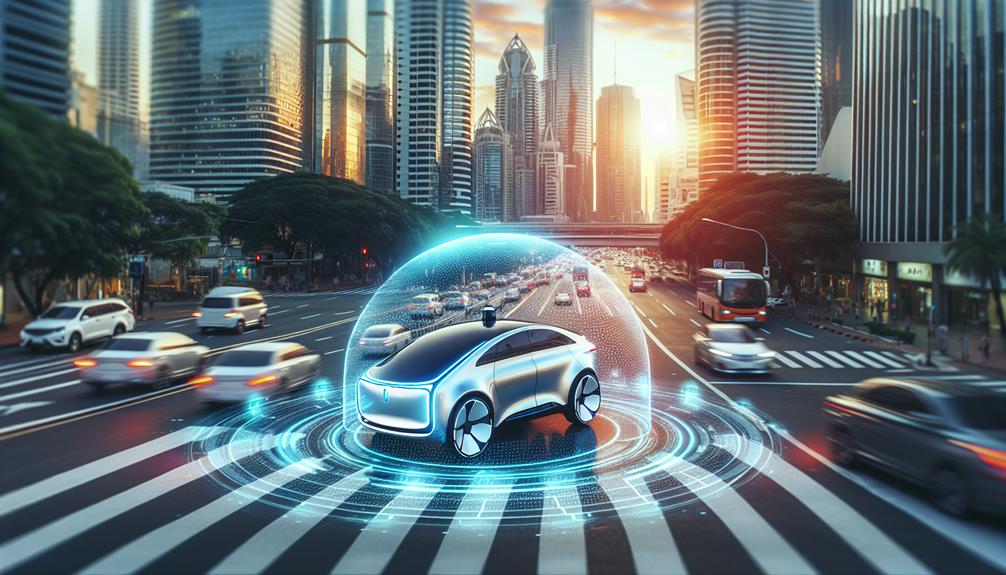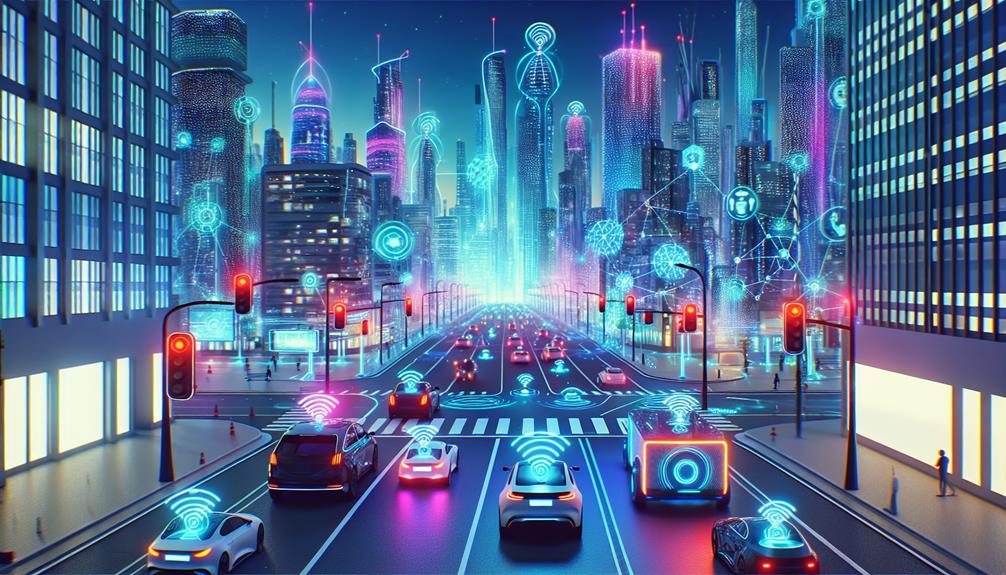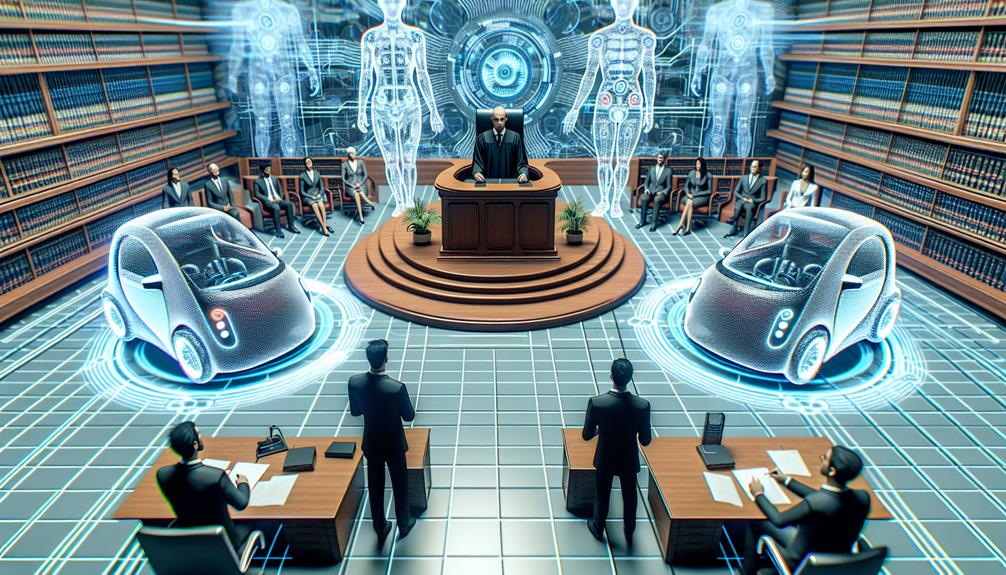Imagine a world where cars glide effortlessly down the road, their sleek bodies cutting through the air like graceful swans. No longer bound by the limitations of human error, these autonomous vehicles navigate with precision and adaptability, seamlessly blending into the fabric of our daily lives. But what lies ahead for these marvels of technology? What new frontiers will they conquer, and what challenges will they face? Step into the realm of autonomous vehicles, where safety, artificial intelligence, connectivity, and public transportation converge to shape the future of transportation. Get ready to witness a revolution that will redefine the way we move, forever.
Key Takeaways
- Safety and efficiency features in autonomous vehicles, such as driver assistance systems and collision avoidance technology, contribute to reducing accidents and improving overall efficiency.
- Artificial intelligence and decision-making algorithms enable continuous learning and improvement in autonomous vehicles, allowing them to detect and avoid obstacles and predict the behavior of other vehicles.
- Connectivity and communication technologies, such as 5G and vehicle-to-vehicle communication, facilitate real-time coordination between vehicles, leading to reduced collisions and optimized routes.
- The evolution of autonomous vehicles has significant applications in public transportation, including reducing traffic congestion and emissions, optimizing routes, and maximizing parking resources through advanced sensors and communication systems.
Improved Safety Features

Buckle up and get ready for a ride because the next wave of autonomous vehicles is bringing with it a host of improved safety features that will revolutionize the way we travel. With the advent of driver assistance systems and collision avoidance technology, the roads are about to become a much safer place.
Imagine a world where accidents are a thing of the past. Autonomous vehicles are equipped with advanced driver assistance systems that constantly monitor the road and surrounding vehicles, ensuring a safe and smooth journey. These systems use a combination of sensors, cameras, and radar to detect potential hazards and take evasive action if necessary. From automatically braking in emergency situations to keeping a safe distance from other vehicles, these safety features are designed to prevent collisions and keep you out of harm's way.
Collision avoidance technology takes safety to a whole new level. Using sophisticated algorithms, autonomous vehicles can predict the movements of other vehicles and pedestrians, allowing them to react and avoid accidents before they even happen. This technology not only saves lives but also reduces traffic congestion and improves overall efficiency on the roads.
Advancements in Artificial Intelligence
Get ready to witness the next leap forward in autonomous vehicles as we explore the exciting advancements in Artificial Intelligence that are propelling this technology into the future. One of the key drivers behind the evolution of autonomous vehicles is the development of machine learning algorithms. These algorithms enable vehicles to continuously learn and improve their driving capabilities based on real-time data and experiences, making them smarter and more efficient.
Machine learning algorithms allow autonomous vehicles to process vast amounts of information from sensors, cameras, and other sources to make split-second decisions on the road. They can not only detect and avoid obstacles but also predict the behavior of other vehicles and pedestrians, ensuring a safer and more reliable driving experience.
However, as we embrace the potential of AI in autonomous vehicles, ethical considerations come into play. How should these vehicles make decisions in complex scenarios where there could be potential harm to humans? Should they prioritize the safety of their occupants or the safety of others? These are challenging questions that require careful thought and deliberation.
To address these ethical dilemmas, researchers are working on developing frameworks that incorporate societal values into the decision-making process of autonomous vehicles. By considering a range of factors, such as minimizing harm, following traffic laws, and respecting human dignity, we can ensure that AI-powered autonomous vehicles operate in a responsible and ethical manner.
Enhanced Connectivity and Communication

Enhanced connectivity and communication revolutionize the way autonomous vehicles interact with their environment, paving the way for safer, more efficient, and collaborative driving experiences. With the integration of 5G technology, vehicles are now able to communicate with each other in real-time, sharing vital information that enhances overall safety on the road. Here are three key ways in which enhanced connectivity and communication are transforming the autonomous vehicle landscape:
- Vehicle-to-vehicle communication: By establishing a network of communication between vehicles, autonomous cars can exchange information regarding their speed, location, and intended actions. This enables them to coordinate their movements, reducing the risk of collisions and ensuring smoother traffic flow.
- Enhanced situational awareness: Through advanced connectivity, autonomous vehicles can access data from various sources, such as traffic cameras, road sensors, and GPS systems. This wealth of information allows them to make informed decisions, adapting their driving behavior to changing road conditions in real-time.
- Collaborative driving experiences: Enhanced connectivity enables autonomous vehicles to work together as a team, sharing the workload and optimizing routes. For example, a group of self-driving cars can coordinate their movements to create platoons, reducing aerodynamic drag and improving fuel efficiency.
With vehicle-to-vehicle communication and 5G integration, autonomous vehicles are becoming more than just individual entities on the road. They are part of a connected ecosystem that prioritizes safety, efficiency, and collaboration, taking us closer to a future of truly autonomous driving.
Expanded Applications in Public Transportation
Public transportation is taking a leap into the future with the expanded applications of autonomous vehicles. Imagine a world where smart cities are seamlessly connected by a fleet of self-driving buses, shuttles, and trains. This revolutionary technology is not only transforming the way we travel but also bringing numerous environmental benefits.
Autonomous vehicles in public transportation have the potential to reduce traffic congestion and emissions significantly. With their advanced sensors and communication systems, these vehicles can optimize routes, avoid traffic jams, and decrease idle time. This means fewer vehicles on the road, leading to cleaner air and a healthier environment. Additionally, autonomous public transportation can also help to address the issue of limited parking spaces in urban areas. By efficiently picking up and dropping off passengers, these vehicles can maximize parking resources and reduce the need for large parking lots.
Moreover, the use of autonomous vehicles in public transportation promotes the concept of smart cities. These vehicles can be integrated with smart infrastructure, such as traffic lights and road sensors, to create a seamless and efficient transportation network. This integration allows for real-time data collection and analysis, enabling transportation authorities to make informed decisions and improve overall system performance.
Regulatory Challenges and Legal Framework

Now that we've explored the promising applications of autonomous vehicles in public transportation, let's dive into the regulatory challenges and legal framework that surround this groundbreaking technology. While autonomous vehicles have the potential to revolutionize transportation, there are several regulatory hurdles that need to be addressed before they can become a common sight on our roads.
- Regulatory Compliance: One of the biggest challenges is establishing a regulatory framework that ensures the safe operation of autonomous vehicles. This involves developing standards for vehicle performance, data privacy, and cybersecurity. It also requires coordination between federal, state, and local authorities to create consistent regulations across different jurisdictions.
- Liability Issues: Another key concern is determining who is responsible in the event of an accident involving an autonomous vehicle. Traditional liability laws may need to be updated to account for situations where the vehicle itself is driving. Should the manufacturer, the operator, or the owner be held accountable? Resolving these liability issues is crucial to ensure fairness and protect the rights of all parties involved.
- Public Acceptance: Autonomous vehicles are still a relatively new technology, and gaining public trust is essential for their widespread adoption. Building public confidence requires transparent communication about the technology's capabilities, limitations, and safety measures. It also involves addressing concerns about job displacement, data security, and ethical considerations.
Navigating the regulatory challenges and legal framework surrounding autonomous vehicles is no easy task. However, by addressing issues related to regulatory compliance and liability, while also building public acceptance, we can unlock the full potential of this transformative technology.
Impact on Urban Infrastructure
The growth of autonomous vehicles is set to reshape urban infrastructure, creating a landscape that is seamlessly connected and optimized for efficient transportation. As autonomous vehicles become more prevalent, cities are looking for ways to integrate them into their smart city initiatives. Smart city integration involves using technology to improve the quality of life for citizens, and autonomous vehicles are a key component of this vision.
One area where autonomous vehicles will have a significant impact is traffic management. With the ability to communicate with each other and with traffic infrastructure, autonomous vehicles can navigate through city streets more efficiently, reducing congestion and improving the flow of traffic. Traffic lights can be synchronized to accommodate the movement of autonomous vehicles, ensuring a smoother and safer driving experience for everyone.
In addition to traffic management, the integration of autonomous vehicles into urban infrastructure will also require changes to parking infrastructure. With autonomous vehicles able to drop off passengers and find parking on their own, the need for large parking lots and garages will decrease. This will free up valuable space in cities for other uses, such as parks or commercial development.
Conclusion
Congratulations! You've just taken a thrilling ride into the future of autonomous vehicles. Buckle up, because the evolution doesn't stop here. With improved safety features, advancements in artificial intelligence, enhanced connectivity, and expanded applications in public transportation, self-driving cars are set to revolutionize the way we travel. But don't forget about the regulatory challenges and legal framework that need to be addressed. So, hold on tight as we navigate the twists and turns of this exciting journey, where autonomous vehicles will reshape our urban infrastructure in ways we can only imagine. Get ready for the ride of your life!


